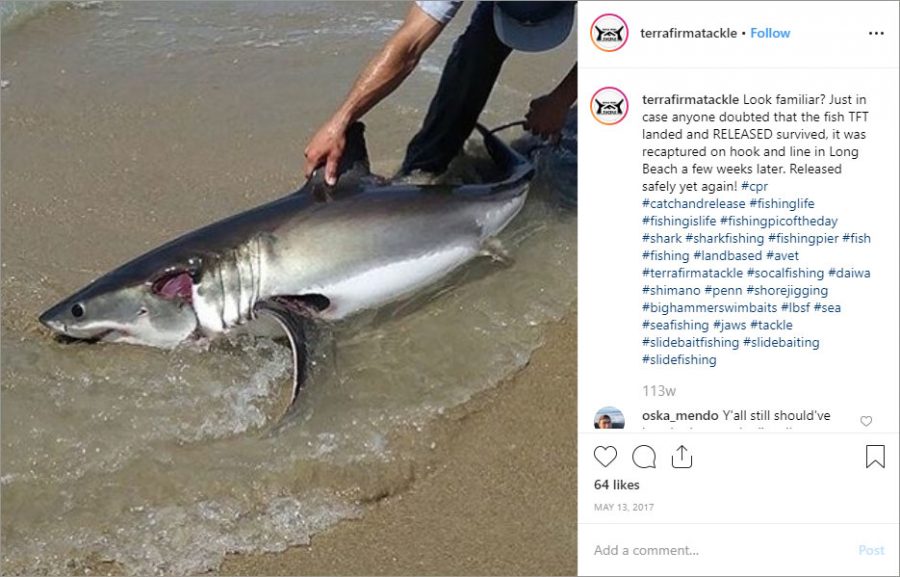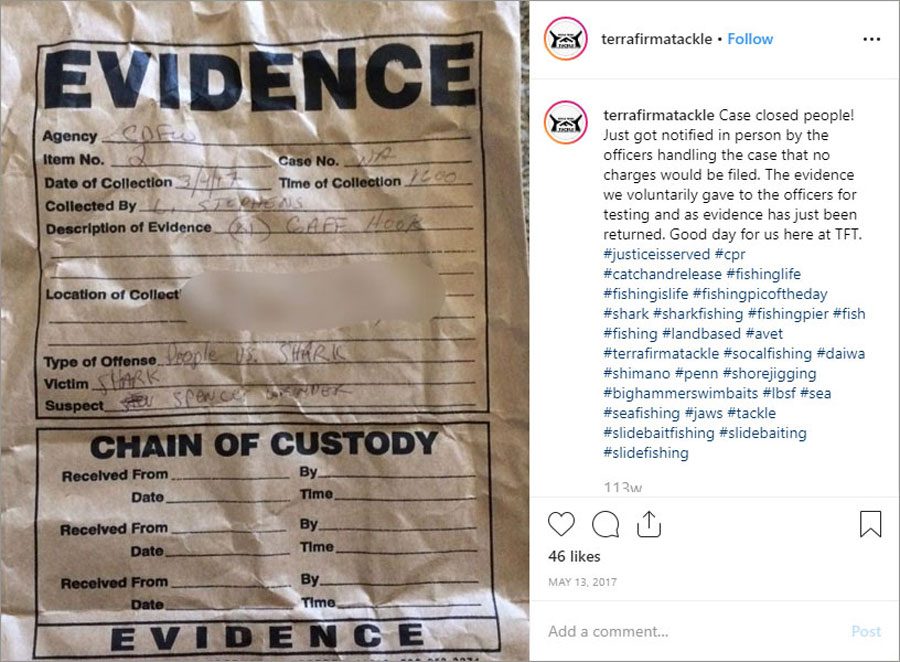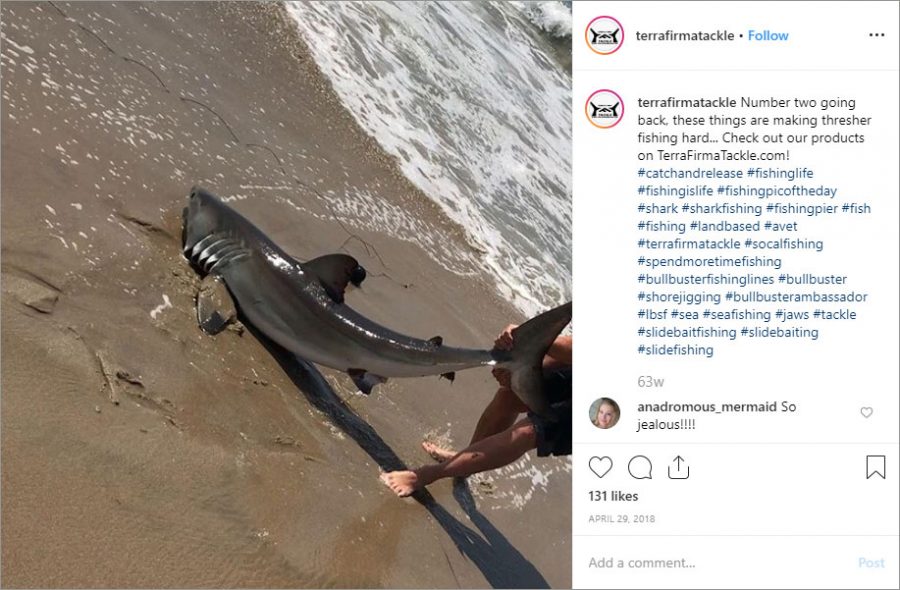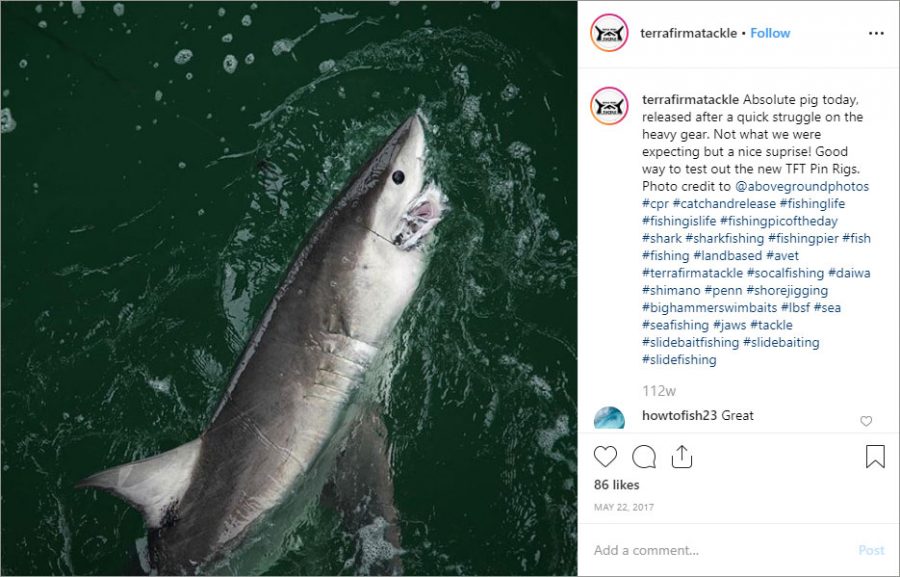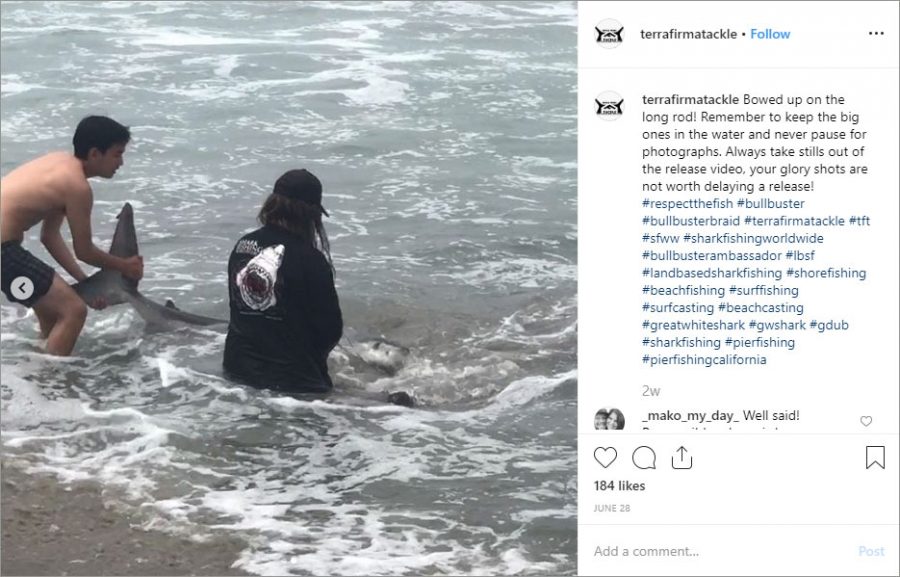Gray Laws on White Sharks
A loophole in California law is letting fishers who repeatedly catch great white sharks off the hook.
Article body copy
As of January 1, 2023, there are new laws in California to protect white sharks. Read more in “California’s Slightly Less Gray Laws on White Sharks” published in December 2022.
People are chattering excitedly at the railing of the Huntington Beach Pier in Southern California. One of them, using heavy fishing tackle, has apparently hooked and played out a one-and-a-half-meter-long shark. The angler’s companions lower a large hook on a rope into the water, gaff the exhausted fish in the head, and hoist it up to the pier.
Shaky cellphone video footage shows the animal levitating toward the pier while the fishers shout excitedly. Eager arms reach out and pull the shark over the railing. The fish is bleeding, one of its left gill slits is badly torn. As it rolls onto the asphalt, the group erupts in triumphant applause. The anglers have landed a young great white shark, a protected species in California.
As the group celebrates, Spencer Wonder, a shark fishing enthusiast, is seen quickly kneeling beside the fish and attempting to unhook it. Then, the footage ends.
Months later, Wonder says he believed the shark was a great white. Others in the group, he recalls, insisted it was a mako, a species anglers can legally catch and keep in California.
“I was totally against gaffing it,” Wonder says. Fishers use a gaff—a large hook on the end of a pole or rope—to help land a fish. But gaffing a fish can be lethal for the animal, and anglers tend to avoid the tactic if they intend to put the fish back alive. The fishers could have, and certainly should have, cut the line to free the shark. Instead, they brought it onto the pier.
The crew of anglers briefly tussled with the shark and posed for photos before dropping it back into the water. Wonder says he feared the shark would die from the gaff wound. He says he was as afraid of the legal consequences of killing the great white as he was that they’d seriously hurt the animal.
The shark, apparently, survived. A photo on Wonder’s Instagram shows an unidentified angler in the surf wrestling with what seems to be the same fish, recognizable by its markings and the healing wound. The caption in the margin says the recapture occurred “a few weeks later.”
The Huntington Beach Pier event, in 2017, drew media attention because it was caught on video. But it was hardly an anomaly. Over the past few years, anglers fishing from piers and beaches in Southern California have caught, and usually released, great white sharks on scores of occasions. Now, critics are blowing the whistle on anglers they feel are breaking the law.
State regulations say that catching a white shark is illegal. Specifically, the rules state that, barring a very specific exemption for research purposes, a “white shark may not be taken.” The document defines “take” as “hunt, pursue, catch, capture or kill … or attempting to do so.” Taking a great white is a misdemeanor, and those found guilty face a fine or jail time.
Despite the way the law is phrased, wardens with the California Department of Fish and Wildlife (CDFW), the state agency that regulates fishing and hunting, seem compelled to prove that a captured white shark was killed or that the angler had intentionally hooked the animal.
“Essentially,” says Jordan Traverso, deputy director of communications for the CDFW, “if the catch is incidental to legal sportfishing activity and the shark is immediately released, then we would likely not see it as a violation,” adding that “other facts at hand could change that.”
This interpretation has created a regulatory gray area in which a person may repeatedly catch and release white sharks without consequences.
Chris Lowe, a biologist and director of the Shark Lab at California State University, Long Beach, is frustrated that anglers are managing to squeeze through loopholes in a law that he calls “toothless.” He thinks some anglers are deliberately targeting great whites and have learned that officials are powerless to stop them if they simply release the fish and claim they were targeting other species.
“This whole concept of deliberately targeting is really hard to prove,” he says. “As long as they throw it back … the state goes, ‘Well, we can’t prosecute that.’”
Mike Stefanak, the CDFW’s marine enforcement district assistant chief, agrees that the language regulating the take of fish and other animals isn’t necessarily clear. “There are always areas of the law that tend to be gray,” he says, adding that “without statements from witnesses, or statements from other participants,” proving that an angler was fishing specifically for great whites is “very difficult.”
California first afforded great whites legal protection in 1994, but it’s not clear how many times an angler has been apprehended for catching one. Stefanak only knows of two incidents in the past five years in which a sport angler was successfully prosecuted for catching a great white. (He said searching the entire historical record would be an almost impossibly time-consuming task.)
The Huntington Beach Pier case is one that made it halfway. The Orange County District Attorney took on the case but after about two months decided against filing charges. Michelle Van Der Linden, a spokesperson for the office of then-district attorney Tony Rackauckas, explained in an email to John Gorman, a local resident and concerned citizen, that the case was dropped partly because “experts could not confirm the species was a great white shark.”
But at least one shark expert could. In March 2017, Drew Scerbo, a marine biologist and scientific adviser for White Shark Advocacy, emailed a detailed report to the CDFW describing how multiple visible physical characteristics of the shark, as seen in the video footage and photos, clearly show that it’s a great white not a mako. Other scientists, including Lowe, have since echoed Scerbo’s judgment.
It is not clear what experts gave the district attorney their opinion. The district attorney’s office has not responded to repeated requests for comment.
Authorities’ soft stance may be emboldening those keen on catching a great white, warns Gorman, who is concerned about what he sees as years of growing interest in shark fishing in the region, as well as other parts of the world. Gorman encouraged the Orange County District Attorney to press charges against the anglers involved in the Huntington Beach Pier case, and he believes the decision to drop the case in 2017 has led to more shark fishing.
“The word is out amongst the fishing community that there’s nothing the law can do to stop you,” Gorman says. “All you have to do is stand there and say, ‘Hey, I wasn’t trying to catch one of those, I was trying to catch one of these.’”
That’s more or less what Wonder says when he catches a great white—which happens all the time.
No one knows for certain how many white sharks live off California, though many researchers believe their population is growing. Estimates for the entire northeast Pacific range from the low 300s to about 3,000. But starting around 2015, the year that an El Niño caused significant warming of California’s coastal waters, juvenile and adolescent white sharks changed their migratory behavior—they stopped swimming to Mexico in the winter and started hanging off California year-round.
Since this increased presence of white sharks began, Wonder has caught and released dozens of the animals.
“We stopped counting at 67, but that was a long time ago,” he says. “We’ve tried to avoid them.”
Great whites cruise the same beaches as the shark species Wonder says he prefers to catch, like threshers, soupfins, and sevengills. As a result, he says, it’s almost impossible for him and his companions not to catch them. On some mornings, he and his fishing companions have hooked more than 10 great whites before 9:00 a.m., though now, he says, they’ve taken to changing locations if they catch more than one.
As a businessman, Wonder has benefited from catching so many great whites. He owns a company, Terra Firma Tackle, that sells shark fishing gear, including leaders—hooks connected to long lengths of bite-resistant wire—suitable for landing very large sharks. Wonder says each photo of a great white that he posts to Instagram “is a sale.”
On August 17, 2017, Wonder posted a comment on one such photo in which he called the catch of a particularly large great white “a milestone.” More recently, in a post from December 2018, he said a mid-sized great white was in the “top 10 for sure, but still a long way from crushing [my personal best] from two years ago.”
Wonder denies that this language suggests an intent to catch great whites. He says he appreciates his interactions with the fish but insists any great white he hooks is an incidental catch. He even describes the sharks as bait-stealing nuisance fish that disrupt outings geared toward smaller, legal game species.
Wonder fishes using big game rods and reels, fighting harnesses, and heavy wire leaders. To Gorman and other critics, that grade of gear is clearly overkill for the species Wonder says he’s targeting. They see this big game tackle as evidence Wonder is trying to catch great whites and say it’s implausible that he is catching every one of the protected animals by accident.
Gorman says there is absolutely no doubt in his mind that fishers are targeting great whites. “Specifically, when particular individuals repeatedly keep catching them, repeatedly keep fishing in the same exact hotspots. They continue to show up with all of the gear that is absolutely necessary, not just for catching, but also for releasing, these animals.
“If they are in fact targeting other species, how is it that they continue to catch great whites?”
Lowe says the repetitive nature of the events, combined with anglers’ use of such heavy gear, makes it obvious what they are trying to catch.
Wonder is certainly not the only angler catching great whites off California’s beaches and piers. Others, however, might not be as quick to get the shark back in the water.
Last year, British documentary filmmaker Jason Perryman visited Southern California to interview shark anglers for an upcoming project about human interactions with great whites.
Perryman spoke at length with one fisherman who described catching a great white from a beach. The shark repeatedly went belly-up in the surf. The angler held the animal in the water, allowing it to process oxygen and recover for more than 20 minutes before it could swim away. Perryman suspects anglers are releasing great whites too exhausted to swim. Lowe, too, suspects the worst for some great whites: “Sharks are being killed—there’s no doubt.”
In the rare case in which there is a successful prosecution, the punishment, shark advocates say, hardly matches the crime.
In January, a series of photos was posted to Facebook showing a group of anglers posing with a bloodied and dead great white. Prosecution followed, and in April 2019, 21-year-old Bodi Dee Roberts received a US $250 fine and three years of probation. In 2016, 25-year-old Joshua Ramsey Carr was sentenced to a year of probation and ordered to serve 60 hours of community service for the illegal take of a white shark. He also received a $500 fine.
“That’s the price of a fishing trip,” says Sean Van Sommeran, founder of the Pelagic Shark Research Foundation in Santa Cruz, California. “The fine for killing one needs to be higher—it’s not unaffordable, and for a lot of these guys, catching a great white is a bucket list thing.”
In the 1990s, Van Sommeran advised the lawmakers who helped draft the language that gave great whites their protected status. But now, he says, the law is “like brochure filler—it doesn’t really amount to anything.”
California is not the only place where fishing for large sharks has prompted alarm. In Florida, a new law was passed earlier this year that prohibits anglers from removing protected sharks from the water. The new regulations require that protected sharks, including great whites, great hammerheads, and tigers, “be released without delay,” and that they “remain in the water with the gills submerged.”
The law, which took effect in July, also prohibits beach fishermen from chumming the water to attract sharks—a practice that opponents argue was creating safety issues for swimmers. The action came after years of increasing concern that recreational fishermen were inadvertently harming or killing the sharks that they beached. Hauling a shark from the water can cause injuries and stress that can kill it even after it is unhooked and released.
Similar concerns apply to white sharks in California, and Van Sommeran thinks the state law protecting them must be upgraded. He suggests an addendum that places restrictions on the type of gear anglers can use, especially in regions frequented by young great whites. Restricting the use of wire leaders and barbed hooks, he suggests, could protect great whites while allowing anglers using plastic leaders to still catch smaller threshers, leopard sharks, and bat rays.
Wonder supports amending the California law so it allows fishing for great whites but simply requires in clear language that the fish be released unharmed.
Stefanak declined to comment on hypothetical changes to California’s fish and game code, though he says the public is welcome to formally propose amendments to fishing regulations by submitting them in writing to the California Fish and Game Commission.
Lowe is more clear cut.
“There are going to have to be some changes … to the law if the true intent is to try to treat [great whites] as a prohibited species,” Lowe says.
For now, the law as written seems clear and simple: catching, capturing, or killing a white shark in California is illegal. Yet thanks to semantic loopholes and uncertainties, enforcing this law has become an almost impossible task.
As of January 1, 2023, there are new laws in California to protect white sharks. Read more in “California’s Slightly Less Gray Laws on White Sharks” published in December 2022.


